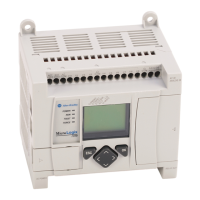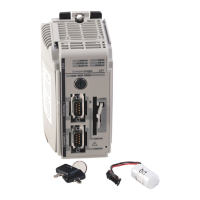86 Rockwell Automation Publication 1766-UM001O-EN-P - September 2021
Chapter 5 LCD and Keypad
download your application program to the controller. The TUF element can
only be changed by a program download.
The value stored in the TUF element identifies the integer file with which the
LCD interfaces. Valid integer files are N7, and N10…N255. When the LCD reads
a valid integer file number, it can access up to 256 bits (0…255) on the LCD
screen. The protection bit (LCD edit disable) in the data file properties of the
target integer file are used to define the read-only or read/write privileges for
its file.
Valid file type include Bit, Integer, Double integer or Float, as specified in the
TUF element.
The example below shows how the LCD uses the configuration information
with integer file number 7 (LCD:0.TUF=7).
The data protection for its file depends on the setting for LCD Edit Disable. If
LCD Edit Disable is set to 1 in file properties, the corresponding data file is
considered read-only by the LCD and the “Protected!” message displays.
For explanations in this section, we assume the following in the application
program:
• An integer file N7, which is 256 elements long (256 words), is defined with
the preset data, as shown.
IMPORTANT Use your programming software to ensure that the integer file you specify
in the TUF element, as well as the appropriate number of elements, exists
in the MicroLogix 1400 user program.
IMPORTANT Although you cannot change protected data from the LCD keypad, the
control program or other communication devices have access to protected
data. Protection bits do not provide any overwrite protection to data within
the target integer file. It is entirely the user’s responsibility to ensure that
data is not inadvertently overwritten.
The LCD always starts at word 0 of a data file. It cannot start at any other address
within the file.

